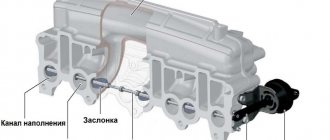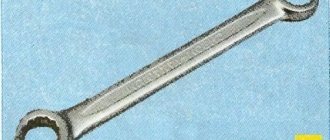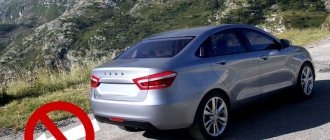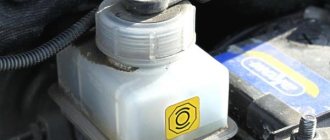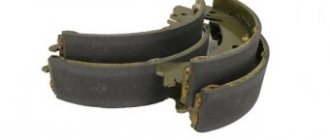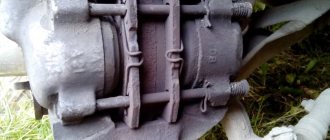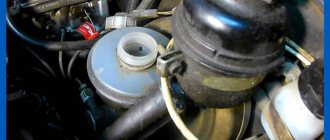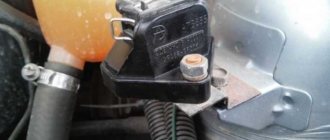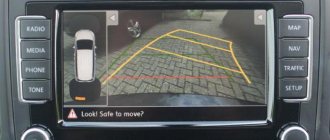It is important for every driver to remember that his car cannot stop instantly. To do this, he will need a certain time, which is influenced by a large number of factors. Traffic rules require maintaining a safe distance between your own car and the car in front in order to have time to brake if necessary. To know the magnitude of this distance, you need to have an idea of the braking distance. In addition, many people confuse two concepts - braking and stopping distance.
Concept of car braking distance
Even if a professional driver is driving a car, a situation may always arise on the road when it is necessary to stop the vehicle as quickly as possible:
- sudden appearance of a person or animal on the road;
- vehicle malfunction;
- violation of traffic rules by another driver, which leads to the creation of an emergency situation;
- unforeseen circumstances: uneven road surface, obstacle (fallen tree, stone), etc.
To stop the car, the driver uses the brake pedal, activating its braking system.
The braking distance of a car is the distance covered by the vehicle during the period of time from the moment the braking system is activated until the vehicle reaches a speed of 0 km/h.
What is the braking distance formula?
In general, car braking is divided into two types. For example, there is normal braking, and there is emergency braking, when you need to suddenly stop the car to avoid an accident.
When braking in everyday life, for example, if you want to stop a car at a traffic light, you usually press the brake pedal much smoother and softer than if you need to completely stop the car in a parking lot. In this case, you are not applying maximum braking force to the car. With such smooth and soft braking, as a rule, the braking distance (braking distance) increases. The approximate stopping distance for normal braking can be calculated using the following simple formula:
(Speed in km/h: 10) x (speed in km/h: 10) = braking distance in meters
During emergency braking, the brake pedal is usually pressed fully and with full force. Due to the higher braking force, the stopping distance of the car is usually reduced by about 2 times. Therefore, the braking distance can also be calculated using the following formula:
(Speed in km/h : 10) x (speed in km/h : 10) / 2 = braking distance in meters
Attention: The braking distance calculated using these formulas is only an approximate value and a hint for drivers. In fact, in reality the braking distance can be either shorter or longer. After all, the braking distance depends on the driver’s driving skills and experience, the technical condition of the car, its design, make, model, road conditions, the condition of the tire tread and many other factors that directly affect the braking distance. But thanks to these formulas, you can approximately calculate the average braking distance of a car at a certain speed. This will allow you to adjust your driving style and will also be a good guide for novice drivers.
What does braking distance depend on?
Obviously, the braking distance will vary depending on the situation and its conditions. Thus, factors influencing the magnitude of this path are divided into two groups:
- Factors that depend on the motorist.
- Factors that are beyond the control of the motorist.
Conditions that are independent of who is driving include weather and road surface conditions. As for the weather, it is logical that in rain, snow or ice it will take more time to stop the car than in dry weather.
The road surface also affects braking distance. If the road is smooth without adding stone, then the distance that the vehicle will travel when braking will also be greater.
On a note! If there are potholes on the roads, then most likely the braking distance will be short. This is due to the fact that on such a bad section of the road the driver simply will not reach high speed.
There are many more factors that depend on the driver (car owner):
- speed. Logically, the lower the speed, the shorter the braking distance;
- condition and design of the brake system. It is important that the car, including its brakes, works properly, that the pads are not worn out, and that the tire pressure is sufficient.
- type of tires installed. The tread should not be heavily worn, and the type of tire installed should be suitable for weather conditions;
- loading the car. The lighter the vehicle, the easier it is to stop it. The braking distance of a loaded vehicle will be longer;
- presence of ABS system. On dry asphalt, this system will help stop the car faster, but in icy conditions it will allow you to maintain control, but the braking distance will become longer;
- sober state of the driver. An adequate driver reacts faster to a rapidly changing situation on the road, thanks to which he will quickly stop his vehicle if necessary;
- absence of distractions while driving. Often, a motorist's slow reaction is due to the fact that he is distracted and does not watch the road. The most common distraction is the mobile phone. Due to the slower reaction of the person driving the car, the braking distance increases.
Different braking conditions
Let's consider the following conditions:
- wet asphalt, snow, ice,
- dry asphalt.
Dry asphalt
On dry asphalt, the tire's adhesion coefficient is 0.7–0.8. This is an excellent indicator.
Wet asphalt, ice, snow
On wet asphalt the coefficient of adhesion is 0,4–0,5.
Determining car speed using braking distance
It is quite difficult to calculate using the formula. To determine the speed of the car, you can use special online calculators. You can find such an online calculator in a search engine.
Online calculators are designed taking into account all requirements. They take into account all the data and formulas.
You only need to enter the following data:
- braking trace length,
- type of road surface,
- vehicle load level,
- car type,
- movement speed.
Next, the online calculator will do all the work for you.
Now let's look at the formula for determining the speed of movement. Formula : 0.5 x t3 x j + √2Syu x j.
Description:
- Syu is the length of the trace,
- j - this symbol indicates the deceleration of the vehicle when braking,
- t3 is the increase in deceleration of the car,
- Va is the initial speed of the machine.
What is the difference between braking distance and stopping distance?
Braking and stopping distances are different concepts that are often confused or mistaken for the same thing.
The stopping distance is the distance that the vehicle has traveled from the moment the motorist realizes the need to stop until the car reaches a speed of 0 km/h.
And the braking distance is the distance that the car has traveled from the moment its brakes are applied until it stops.
Thus, the stopping distance includes not only the braking distance, but also the distance the vehicle traveled while the motorist was reacting to the traffic situation.
In what cases is a driver prohibited from driving at a speed of more than 50 km/h?
Ticket 32, question 10.
- When driving a moped.
- When towing a motor vehicle.
- If the corresponding prohibition is set by the road sign “Maximum speed limit”.
- In all of the above cases.
A comment:
Paragraph 1.2 of the traffic rules:
“Moped” is a two- or three-wheeled mechanical vehicle, the maximum design speed of which does not exceed 50 km/h, having an internal combustion engine with a displacement not exceeding 50 cubic meters. cm, or an electric motor with a rated maximum power in continuous load mode of more than 0.25 kW and less than 4 kW. Quadricycles with similar technical characteristics are considered equal to mopeds.
Clause 10.4 of the traffic rules:
10.4. Vehicles towing motor vehicles are permitted to travel at a speed of no more than 50 km/h.
Sign 3.24:
3.24 “Maximum speed limit.” It is prohibited to drive at a speed (km/h) exceeding that indicated on the sign.
The correct answer is fourth.
Road conditions.
You also need to know that on a wet or icy road, the braking distance certainly increases. The fact is that on a slippery surface, the car’s grip on the road is greatly reduced, which leads to an increase in braking distance when braking.
For example, in icy conditions the braking distance of any car can increase tenfold!
This is interesting: What is the fuse for the brake light of the VAZ 2110
Distance
- Three car lengths . Anyone traveling in urban areas must maintain a distance of at least 15 meters, or three car lengths.
- Half speedometer : for a safe distance outside of populated areas, pay attention to the speed of the car. In order to calculate a safe distance, divide by 2 the current speed shown by the speedometer. As a result, you will get the distance to other cars in meters. Example: At a speed of 70 km/h, you must keep at least 35 meters from the vehicle in front. Moreover, this applies to dry asphalt in the summer.
- Double distance : In case of poor visibility or bad road conditions, you should double the safe distance.
What factors influence braking and stopping distance?
Check the month of manufacture of the car by VIN. how to find out the year of manufacture of a car? determination of the month of production for individual elements of the car
We already wrote above that the length of the braking distance is influenced by many factors. We invite you to consider them in more detail.
Speed
This is the key factor. This means not only the speed of the car, but also the reaction speed of the driver. It is believed that everyone has approximately the same reaction, but this is not entirely true. Driving experience, a person’s health status, medication use, etc. play a role. Also, many reckless drivers ignore the law and are distracted by smartphones while driving, which ultimately can lead to catastrophic consequences.
Remember one more important point. If a car's speed doubles, its braking distance quadruples! The 1:1 ratio doesn't work here.
Road conditions
Undoubtedly, the length of the brake line is influenced by the condition of the road surface. On an icy or wet road it can increase significantly. But these are not all the factors. You should also be wary of fallen leaves, on which tires glide perfectly, cracks in the surface, holes, and so on.
Tires
The quality and condition of the rubber greatly influence the length of the brake line. Often, more expensive tires provide better grip on the road surface.
Please note that if the tread depth has worn off beyond the permissible value, then the rubber loses its ability to drain a sufficient amount of water when driving on a wet road. As a result, you may encounter such an unpleasant thing as hydroplaning - when the car loses traction and becomes completely uncontrollable.
To shorten the braking distance, it is recommended to maintain optimal tire pressure. Which one exactly - the automaker will answer this question for you. If the value deviates upward or downward, the braking line will increase.
Depending on the coefficient of adhesion of the tires to the road surface, this indicator will vary. Here is a comparative table of the dependence of the braking distance on the quality of the road surface (a passenger car whose tires have an average coefficient of adhesion):
| 60km/h. | 80 km/h. | 90 km/h. | |
| Dry asphalt, m. | 20,2 | 35,9 | 45,5 |
| Wet asphalt, m. | 35,4 | 62,9 | 79,7 |
| Snowy road, m. | 70,8 | 125,9 | 159,4 |
| Ice, m. | 141,7 | 251,9 | 318,8 |
Of course, these indicators are relative, but they clearly illustrate how important it is to monitor the condition of car tires.
Technical condition of the machine
A car can only go on the road in good condition - this is an axiom that does not require proof. To do this, carry out routine diagnostics of your car, make timely repairs and change the brake fluid.
Remember that worn brake rotors can double the brake line.
Distraction on the road
While the vehicle is moving, the driver has no right to be distracted from driving the vehicle and monitoring the traffic situation. Not only its safety, but the lives and health of passengers, as well as other road users, depend on this.
Here's what happens in a driver's brain when an emergency occurs:
- assessment of the road situation;
- making a decision - to brake or maneuver;
- response to the situation.
Depending on the driver's innate abilities, the average reaction speed ranges from 0.8 to 1.0 seconds. This setting concerns an emergency situation, rather than an almost automatic process when slowing down on a familiar stretch of road.
To many, this time period seems insignificant to pay attention to, but ignoring the danger can lead to fatal consequences. Here is a table of the relationship between the driver’s reaction and the distance traveled by the car:
| Vehicle speed, km/h. | Distance until the brake is pressed (the time remains the same - 1 second), m. |
| 60 | 17 |
| 80 | 22 |
| 100 | 28 |
As you can see, even a seemingly insignificant second of delay can lead to dire consequences. That’s why every motorist should never break the rule: “Don’t be distracted and stick to the speed limit!”
Various factors can distract the driver from driving:
- mobile phone - even just to see who is calling (when talking on the phone, the driver’s reaction is identical to the reaction of a person in a state of mild alcohol intoxication);
- watching a passing car nearby or enjoying beautiful scenery;
- fastening the seat belt;
- eating while driving;
- falling of an unsecured DVR or mobile phone;
- clarification of the relationship between driver and passenger.
In fact, it is impossible to make a complete list of all the factors that can distract a driver from driving. In view of this, everyone should be attentive to the road, and passengers will benefit from the habit of not distracting the driver from driving.
Driver reaction time and path
Driver reaction time is the time that will pass from the moment the driver detects a danger on the road until the start of taking measures to prevent it.
The driver's reaction path is the distance the vehicle will travel from the moment the driver detects a hazard on the road until the brake pedal is pressed.
Here is the formula for calculating the distance a car will travel when the driver reacts to danger:
(Speed in km/h: 10) x 3 = reaction distance in meters
Calculation example: imagine that you are driving at a speed of 100 km/h along a country road and suddenly an elk runs out onto the road. Calculation: (100 km/h: 10) x 3 = 30 (meters). That is, after you react to a danger on the road, your car will travel about 30 meters. Add to this the braking distance of the car.
Attention: these rules are not scientifically correct formulas and provide only approximate values!
What is the braking distance of a car?
The braking distance is the distance that the car will travel after activating the brake system until it comes to a complete stop. This is only a technical parameter by which, in combination with other factors, the safety of the car is determined. This parameter does not include the driver's reaction speed.
_
The combination of the driver’s reaction to an emergency situation and the distance from the start of braking (the driver pressed the pedal) to the complete stop of the vehicle is called the stopping distance.
The traffic rules indicate critical parameters under which the operation of a vehicle is prohibited. The maximum limits are:
| Transport type: | Braking distance, m. |
| Motorcycle/moped | 7,5 |
| A car | 14,7 |
| Bus/truck weighing up to 12 tons | 18,3 |
| Truck weighing more than 12 tons | 19,5 |
Since the braking distance directly depends on the speed of the vehicle, the critical indicator is the distance covered by the vehicle mentioned above when the speed decreases from 30 km/h. (for motor vehicles) and 40 km/h. (for cars and buses) to zero.
A braking system that responds too slowly will always result in damage to the vehicle and often injury to those in it. For clarity: a car moving at a speed of 35 km/h will collide with an obstacle with a force identical to the impact of a fall from a five-meter height. If the speed of the car in a collision with an obstacle reaches 55 km/h, then the impact force will be identical to that of a fall from the third floor (90 km/h – a fall from the 9th floor, or from a height of 30 meters).
These research results show how important it is for a motorist to monitor the condition of the car’s braking system, as well as tire wear.
Moped drivers are prohibited from turning left or turning around:
Ticket 37, question 17.
- Only when driving on a road with tram traffic.
- Only when driving on a road that has more than one lane for traffic in a given direction.
- In both of the above cases.
A comment:
The situation is regulated by clause 24.8 of the traffic rules:
24.8. Cyclists and moped drivers are prohibited from:
- drive a bicycle or moped without holding the handlebars with at least one hand;
- transport cargo that protrudes beyond the dimensions by more than 0.5 m in length or width, or cargo that interferes with control;
- transport passengers if this is not provided for by the design of the vehicle;
- transport children under 7 years of age in the absence of specially equipped places for them;
- turn left or turn around on roads with tram traffic and on roads that have more than one lane for traffic in a given direction (except for cases where a left turn is allowed from the right lane, and with the exception of roads located in bicycle zones);
- drive on the road without a fastened motorcycle helmet (for moped drivers); cross the road at pedestrian crossings.
The correct answer is third.
How to brake on a motorcycle?
Braking correctly on a motorcycle is quite a difficult task. You can brake with the rear wheel, the front wheel, or both, skid or engine. If you brake incorrectly at high speeds, you can lose your balance. In order to calculate the braking distance of a motorcycle at 60 km/h, we also substitute the data into the formula. Taking into account the different braking coefficient and friction coefficient.
Motorcycle braking distance
- Dry asphalt: 23 - 33 meters
- Wet asphalt: 35 - 46 meters
- Mud and snow: 70 - 95 meters
- Ice: 95 - 128 meters
The second indicator is the braking distance when the motorcycle is skidding.
Any vehicle owner should know and be able to calculate the braking distance, and it is better to do this visually.
It should be remembered that if a traffic accident occurs, by the length of the skid that will remain on the road surface, you can determine the speed of the vehicle before colliding with an obstacle, which can indicate that the driver has exceeded the permissible speed and make him the culprit of the incident.
Additional braking distance components
When calculating the effectiveness of brakes, the characteristics of the suspension and the condition of the tires are very important. What does the suspension have to do with it? Very simple. It is quite rare to find perfectly smooth asphalt under our wheels, and it is the suspension, or more precisely, shock absorbers, springs, torsion bars and springs that press the wheels to the surface, making braking and steering as efficient as possible. If the shock absorber is faulty, the wheels bounce on bumps and full contact with the surface is out of the question.
Let's add to this the coefficient of adhesion of the rubber to the road - here the condition of the road, the type of tire (winter or summer), tread pattern, geometry, tread wear and the quality of the rubber material are of great importance. Tests have shown that on the same car, but with different tires, the braking distance can vary by up to three to five meters, but there is nothing to say about the quality of the coating. Try to compare braking on dry asphalt and on ice.
As you can see, there are quite a lot of factors influencing the braking distance, and even more so the stopping distance, so maximum concentration of attention while driving is a guarantee of safe driving. Check your brakes on time, don't talk on the phone while driving and may all your roads be good!
